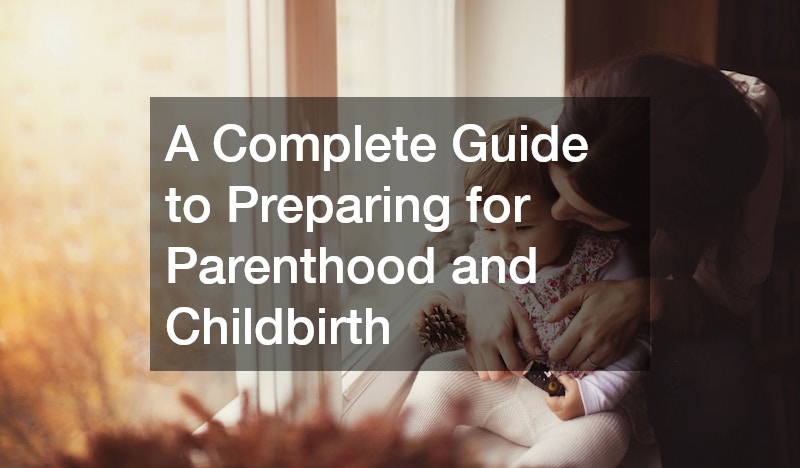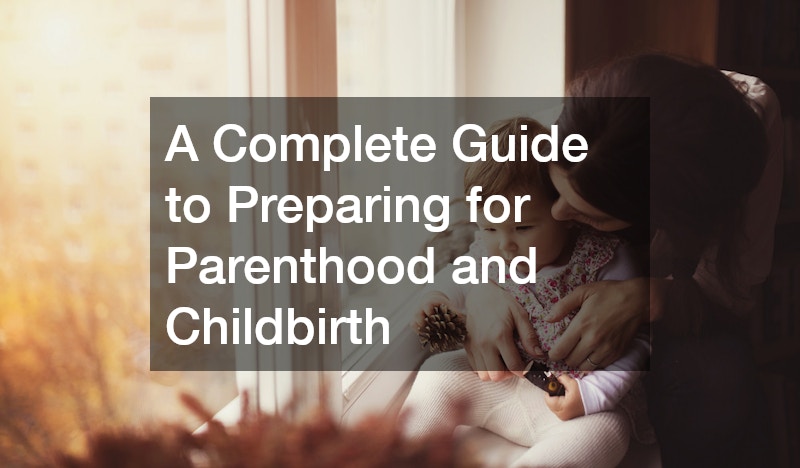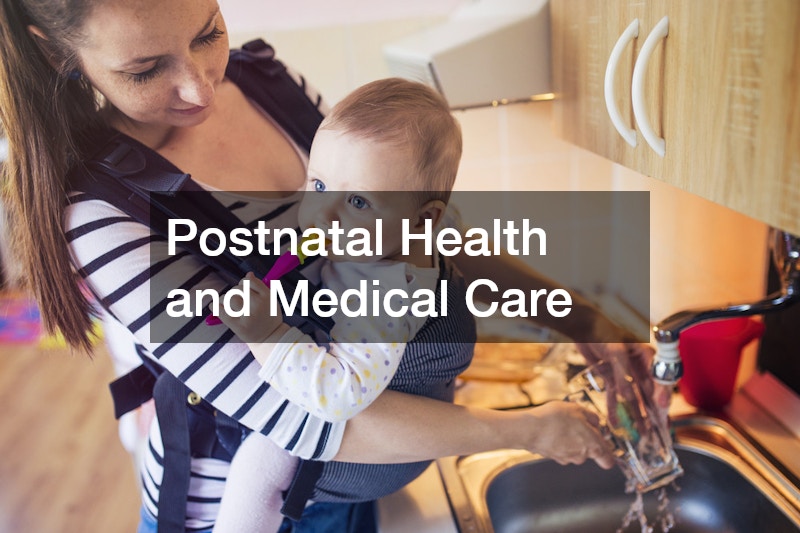
A Complete Guide to Preparing for Parenthood and Childbirth

Becoming a parent is one of the most transformative experiences in life. It brings excitement, joy, and a fair share of challenges. Preparing for parenthood goes beyond picking out cute baby clothes or decorating a nursery. It involves understanding your options, taking care of your health, creating a safe environment, and planning for your own well-being as well as the needs of your growing family.
Proper preparation helps reduce stress, ensures smoother transitions, and sets the stage for a healthy and happy start for both parent and child. This comprehensive guide walks you through everything from pregnancy preparation and childbirth education to home safety, postpartum care, and early childhood education. By following these practical tips, you can feel confident and empowered as you embark on this incredible journey.

1. Exploring Your Options Before Conception
Planning for parenthood begins even before pregnancy. Understanding your choices and considering what aligns with your lifestyle, health, and long-term goals is crucial. Taking time to explore options can reduce stress later and help you feel empowered about the path you choose.
There are several pregnancy options to consider:
-
Natural conception: Trying to conceive without medical intervention, ideal for couples with no fertility challenges. This may involve tracking ovulation, maintaining a healthy lifestyle, and timing intercourse to increase the likelihood of pregnancy.
-
Fertility treatments: Including IVF, IUI, and ovulation tracking for couples facing difficulties conceiving naturally. These options can be tailored to individual needs, but they may require significant financial, emotional, and physical investment.
-
Surrogacy or adoption: Options for individuals or couples who cannot carry a pregnancy themselves or prefer adoption. Surrogacy involves careful legal and medical planning, while adoption requires understanding different processes, timelines, and potential home studies.
Practical tips for exploring the options:
-
Schedule consultations with OB-GYNs, fertility specialists, or adoption agencies to understand risks, timelines, and success rates.
-
Discuss family planning openly with your partner, considering emotional readiness, financial stability, and logistical support, such as work schedules and living arrangements.
-
Maintain a health journal to track menstrual cycles, medications, lifestyle habits, and fertility patterns. This can help identify potential issues and provide useful information for healthcare providers.
-
Educate yourself through books, reputable websites, or support groups to understand each option thoroughly and hear real experiences from other prospective parents.
-
Consider mental health support if needed, as the journey to parenthood can involve stress, anxiety, or difficult decisions. Professional guidance can provide coping strategies and reassurance.
By evaluating all available options early, understanding potential challenges, and preparing both physically and emotionally, you can make informed decisions and move forward with confidence in your path to parenthood.
2. Choosing the Right Prenatal Classes
Education is one of the most empowering tools for new parents. Attending childbirth classes provides practical knowledge and builds confidence before labor and delivery. These classes are not only about understanding the physical process of childbirth—they also help parents prepare emotionally, develop coping strategies, and foster a stronger connection with their support system.
Benefits of prenatal classes:
-
Learn techniques for managing labor pain: Classes often cover breathing exercises, meditation, visualization, and positions that can help reduce discomfort and increase relaxation during labor.
-
Understand stages of labor: Parents gain insight into early labor, active labor, and delivery, including what to expect in a hospital or birthing center, and how to communicate effectively with medical staff.
-
Prepare for postpartum recovery and newborn care: Topics often include feeding options, diapering, soothing techniques, and recognizing signs of common newborn issues. This preparation helps parents feel ready for life at home after birth.
-
Build confidence and reduce anxiety: Knowledge empowers parents to feel in control and make informed decisions, whether it’s choosing a birth plan or responding to unexpected situations.
Tips for selecting a program:
-
Compare hospital-led classes, private instructors, and online courses to find a style that suits your schedule, learning preferences, and comfort level.
-
Check class content to ensure important topics like cesarean sections, emergency procedures, pain management options, breastfeeding support, and newborn care are included.
-
Attend trial sessions if available, or read reviews from previous participants to gauge teaching quality and approachability.
-
Invite partners, doulas, or support persons to join classes for hands-on practice and shared understanding, which helps everyone feel more prepared and involved.
-
Supplement classes with books, videos, or reputable online resources for additional learning and reinforcement.
By taking the time to choose the right prenatal education, parents can approach labor and delivery with confidence, reduce stress, and feel prepared for the early weeks of parenthood. Knowledge is one of the best tools for turning uncertainty into empowerment and ensuring a smoother, more positive birth experience.
3. Nutrition for a Healthy Pregnancy
Proper nutrition during pregnancy is essential for both maternal health and fetal development. A balanced diet supports energy levels, immune function, and healthy weight gain.
Certain supplements can be particularly beneficial. For example, sunflower lecithin is known to support brain development in the fetus and promote maternal health by aiding digestion and reducing cholesterol levels.
Prenatal nutrition tips:
-
Prioritize protein from lean meats, eggs, legumes, and dairy.
-
Include a variety of colorful fruits and vegetables to ensure adequate vitamins and minerals.
-
Incorporate whole grains for sustained energy and fiber.
-
Consider a prenatal vitamin to cover potential nutrient gaps, including folic acid, iron, and DHA.
Sample daily meal plan for expectant mothers:
-
Breakfast: Oatmeal with fresh berries and a tablespoon of sunflower lecithin.
-
Lunch: Quinoa salad with grilled chicken, spinach, and avocado.
-
Snack: Greek yogurt with nuts and a piece of fruit.
-
Dinner: Baked salmon with roasted vegetables and brown rice.
A well-rounded nutritional plan ensures your body is ready for childbirth while supporting your baby’s growth.
4. Preparing a Safe and Functional Nursery
A safe, comfortable nursery is vital for peace of mind and practical daily care. Selecting the right crib is a key step, particularly for parents with mobility challenges. Choosing an accessible crib for disabled parent can make a significant difference. These cribs provide ergonomic design features, adjustable heights, and easy access to the baby, allowing parents with physical limitations to care for their child safely and comfortably.
Nursery safety and organization tips:
-
Position the crib away from windows, cords, and heavy furniture that could pose risks.
-
Keep frequently used items, such as diapers and wipes, within easy reach to reduce strain during nighttime care.
-
Use soft, breathable bedding and avoid pillows or stuffed animals that could increase suffocation risks.
-
Anchor furniture to walls and install outlet covers to prevent accidents.
-
Consider adding mobility-friendly pathways and storage solutions to make daily routines easier for parents with disabilities.
By planning the nursery layout carefully and selecting furniture that meets accessibility needs, parents can focus on bonding and daily routines without worrying about preventable hazards. An accessible crib not only ensures the baby’s safety but also supports the parent’s independence and confidence in caring for their newborn.

5. Securing a Clean and Healthy Home Environment
A newborn’s immune system is fragile, so maintaining a clean and safe home environment is crucial. Mold, dust, and allergens can pose health risks. Engaging local mold removal services can help ensure the home is free of mold, which can trigger respiratory issues for both infants and parents.
Practical steps for a healthy home:
-
Inspect basements, bathrooms, and kitchen areas for leaks and moisture accumulation.
-
Regularly vacuum carpets and clean upholstery to remove dust and allergens.
-
Use natural, non-toxic cleaning products to reduce chemical exposure.
-
Maintain proper ventilation in all rooms to prevent humidity build-up.
Taking these steps protects your newborn while also fostering a cleaner, more comfortable home environment for everyone.
6. Practical Home Maintenance and Safety Tips
Beyond general cleaning, taking proactive steps to baby-proof and maintain your home prevents accidents and ensures convenience.
Medical grade adhesive can be used to secure loose cords, cover sharp edges, or affix safety items like cabinet locks.
Home safety checklist for new parents:
-
Install baby gates at stairs and doorways.
-
Secure heavy furniture to walls to prevent tipping.
-
Keep small objects and choking hazards out of reach.
-
Ensure electrical cords are neatly organized and covered.
-
Store cleaning products and medications in high, locked cabinets.
Implementing these measures early reduces stress and creates a secure environment for both baby and adults.

7. Postnatal Health and Medical Care
After childbirth, the focus shifts to recovery and ensuring the health of both mother and baby. Regular medical care is essential to monitor healing, screen for postpartum depression, and track infant growth and vaccinations.
Postnatal care recommendations:
-
Schedule postpartum checkups at 2–6 weeks after delivery.
-
Attend pediatric appointments for routine growth monitoring and immunizations.
-
Watch for signs of complications, including infections, excessive bleeding, or mood changes.
-
Maintain a balanced diet and hydration to support recovery.
Tips for newborn care at home:
-
Keep a temperature-safe sleeping environment.
-
Monitor feeding schedules and diaper changes to track health.
-
Use supportive pillows and positioning techniques during breastfeeding or bottle-feeding.
Consistent medical follow-up helps identify issues early, ensuring both parent and child remain healthy.

8. Caring for Yourself as a New Parent
Self-care is often overlooked but is essential for long-term well-being. Postpartum recovery involves both physical and emotional aspects. Some parents explore options like laser hair removal for postpartum grooming convenience, saving time during a busy schedule.
Self-care strategies for new parents:
-
Prioritize sleep whenever possible, even in short naps.
-
Accept help from partners, friends, or family for household tasks.
-
Practice gentle exercise like walking or yoga to support physical recovery.
-
Engage in mindfulness or meditation to manage stress.
Maintaining self-care ensures parents are energized, focused, and emotionally resilient during the early months of childcare.
9. Planning for Extended Family and Community Needs
For families living with seniors or extended family members, planning ahead ensures everyone’s needs are met. Exploring senior assisted living options can relieve caregiving pressure while offering seniors professional support.
Tips for multi-generational household planning:
-
Designate separate spaces for seniors to maintain independence.
-
Coordinate schedules to manage overlapping care responsibilities.
-
Use assistive devices, like mobility aids or accessible furniture, to improve safety.
-
Foster communication to align expectations and reduce stress.
By anticipating family dynamics and care needs, parents can balance responsibilities without feeling overwhelmed.
10. Preparing Your Child’s Early Education
Early childhood education lays the foundation for social, emotional, and cognitive development. Choosing a high-quality preschool ensures your child benefits from structured learning and social interaction.
Tips for selecting a preschool:
-
Visit multiple schools to observe teaching styles, classroom dynamics, and safety standards.
-
Check accreditation, staff-to-child ratios, and teacher qualifications.
-
Ask about daily routines, meal plans, and curriculum focus areas.
-
Involve your child in visits to gauge comfort and excitement.
Preparing children for preschool also includes teaching basic independence skills, like handwashing, simple dressing, and following routines. Early education success contributes to confidence and long-term academic and social growth.
Preparing for parenthood and childbirth is a multi-faceted journey that requires planning, education, and proactive steps for both the child and family. From understanding pregnancy options and attending childbirth classes to creating a safe home and maintaining parental well-being, thoughtful preparation ensures a smoother and healthier transition into this new chapter.
By taking the time to plan for nutrition, medical care, home safety, and early education, parents can focus on bonding, enjoying special milestones, and building a strong foundation for their family’s future. Every effort invested in preparation pays off in peace of mind, confidence, and a joyful parenting experience.


